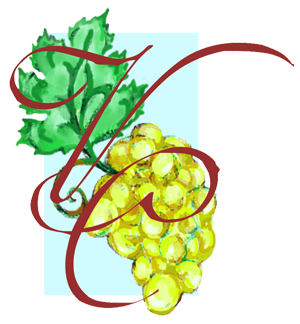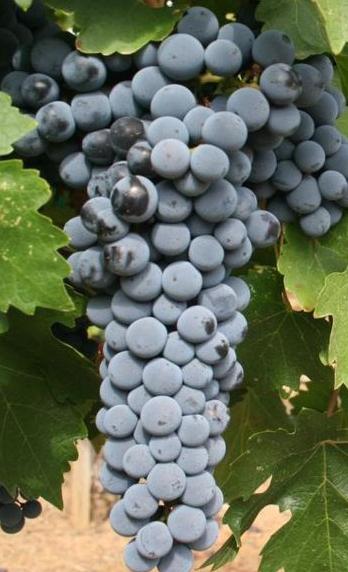Cabernet Sauvignon (French: [kabɛʁnɛ soviˈɲɔ̃]) is one of the world's most widely recognized red wine grape varieties. It is grown in nearly every major wine producing country among a diverse spectrum of climates from Canada's Okanagan Valley to Lebanon's Beqaa Valley. Cabernet Sauvignon became internationally recognized through its prominence in Bordeaux wines where it is often blended with Merlot and Cabernet Franc. From France, the grape spread across Europe and to the New World where it found new homes in places like California's Santa Cruz Mountains, Napa Valley, New Zealand's Hawkes Bay, Australia's Margaret River and Coonawarra regions, and Chile's Maipo Valley and Colchagua. For most of the 20th century, it was the world's most widely planted premium red wine grape until it was surpassed by Merlot in the 1990s.[1]
Despite its prominence in the industry, the grape is a relatively new variety, the product of a chance crossing between Cabernet Franc and Sauvignon blanc during the 17th century in southwestern France. Its popularity is often attributed to its ease of cultivation—the grapes have thick skins and the vines are hardy and naturally low yielding, budding late to avoid frost and resistant to viticultural hazards such as rot and insects—and to its consistent presentation of structure and flavours which express the typical character ("typicity") of the variety. Familiarity and ease of pronunciation have helped to sell Cabernet Sauvignon wines to consumers, even when from unfamiliar wine regions. Its widespread popularity has also contributed to criticism of the grape as a "colonizer" that takes over wine regions at the expense of native grape varieties.[2]
The classic profile of Cabernet Sauvignon tends to be full-bodied wines with high tannins and noticeable acidity that contributes to the wine's aging potential. In cooler climates, Cabernet Sauvignon tends to produce wines with blackcurrant notes that can be accompanied by green bell pepper notes, mint and cedar which will all become more pronounced as the wine ages. In more moderate climates the blackcurrant notes are often seen with black cherry and black olive notes while in very hot climates the currant flavors can veer towards the over-ripe and "jammy" side. In parts of Australia, particularly the Coonawarra wine region of South Australia, Cabernet Sauvignon wines tend to have a characteristic eucalyptus or menthol notes.[3]
While Cabernet Sauvignon can grow in a variety of climates, its suitability as a varietal wine or as a blend component is strongly influenced by the warmth of the climate. The vine is one of the last major grape varieties to bud and ripen (typically 1–2 weeks after Merlot and Cabernet franc[1]) and the climate of the growing season affects how early the grapes will be harvested. Many wine regions in California give the vine an abundance of sunshine with few problems in ripening fully, which increases the likelihood of producing varietal Cabernet wines. In regions like Bordeaux, under the threat of inclement harvest season weather, Cabernet Sauvignon is often harvested a little earlier than ideal and is then blended with other grapes to fill in the gaps. In some regions, climate will be more important than soil. In regions that are too cool, there is a potential for more herbaceous and green bell pepper flavours from less than ideally ripened grapes. In regions where the grape is exposed to excess warmth and over-ripening, there is a propensity for the wine to develop flavours of cooked or stewed blackcurrants.[2]
The Cabernet grape variety has thriven in a variety of vineyard soil types, making the consideration of soil less of concern particularly for New World winemakers. In Bordeaux, the soil aspect of terroir was historically an important consideration in determining which of the major Bordeaux grape varieties were planted. While Merlot seemed to thrive in clay- and limestone-based soils (such as those of the Right Bank regions of the Gironde estuary), Cabernet Sauvignon seemed to perform better in the gravel-based soil of the Médoc region on the Left Bank. The gravel soils offered the benefit of being well drained while absorbing and radiating heat to the vines, aiding ripening. Clay- and limestone-based soils are often cooler, allowing less heat to reach the vines, delaying ripening. In regions where the climate is warmer, there is more emphasis on soil that is less fertile, which promotes less vigor in the vine which can keep yields low.[2] In the Napa Valley wine regions of Oakville and Rutherford, the soil is more alluvial and dusty. Rutherford Cabernet Sauvignon has been often quoted as giving a sense of terroir with a taste of "Rutherford dust".[12] In the South Australian wine region of Coonawarra, Cabernet Sauvignon has produced vastly different results from grape vines planted in the region's terra rosa soil – so much so that the red soil is considered the "boundary" of the wine region, with some controversy from wine growers with Cabernet Sauvignon planted on red soil.[13]
In addition to ripeness levels, the harvest yields can also have a strong influence in the resulting quality and flavors of Cabernet Sauvignon wine. The vine itself is prone to vigorous yields, particularly when planted on the vigorous SO4 rootstock. Excessive yields can result in less concentrated and flavorful wine with flavors more on the green or herbaceous side. In the 1970s, a particular clone of Cabernet Sauvignon that was engineered to be virus free was noted for its very high yields-causing many quality conscious producers to replant their vineyards in the late 20th century with different clonal varieties. To reduce yields, producers can plant the vines on less vigorous rootstock and also practice green harvesting with aggressive pruning of grape clusters soon after veraison.[2]
In general, Cabernet Sauvignon has good resistance to most grape diseases, powdery mildew being the most noted exception. It is, however, susceptible to the vine diseases Eutypella scoparia and excoriose.[1]
In many aspects, Cabernet Sauvignon can reflect the desires and personality of the winemaker while still presenting familiar flavors that express the typical character of the variety. The most pronounced effects are from the use of oak during production. Typically the first winemaking decision is whether or not to produce a varietal or blended wine. The "Bordeaux blend" of Cabernet Sauvignon, Merlot and Cabernet franc, with potentially some Malbec, Petit Verdot or Carménère, is the classic example of blended Cabernet Sauvignon, emulated in the United States with wines produced under the "Meritage" designation. But Cabernet Sauvignon can be blended with a variety of grapes such as Shiraz, Tempranillo and Sangiovese.[2] The decision to blend is then followed by the decision of when to do the blending—before, during or after fermentation. Due to the different fermentation styles of the grapes, many producers will ferment and age each grape variety separately and blend the wine shortly before bottling.[14]
The Cabernet Sauvignon grape itself is very small, with a thick skin, creating a high 1:12 ratio of seed (pip) to fruit (pulp).[15] From these elements the high proportions of phenols and tannins can have a stark influence on the structure and flavor of the wine—especially if the must is subjected to long periods of maceration (skin contact) before fermentation. In Bordeaux, the maceration period was traditionally three weeks, which gave the winemaking staff enough time to close down the estate after harvest to take a hunting holiday. The results of these long maceration periods are very tannic and flavorful wines that require years of aging. Wine producers that wish to make a wine more approachable within a couple of years will drastically reduce the maceration time to as a little as a few days. Following maceration, the Cabernet must can be fermented at high temperatures up to 30 °C (86 °F). The temperature of fermentation will play a role in the result, with deeper colors and more flavor components being extracted at higher temperatures while more fruit flavors are maintained at lower temperature. In Australia there has been experimentation with carbonic maceration to make softer, fruity Cabernet Sauvignon wines.[2]
The tannic nature of Cabernet Sauvignon is an important winemaking consideration. As the must is exposed to prolonged periods of maceration, more tannins are extracted from the skin and will be present in the resulting wine. If winemakers choose not to shorten the period of maceration, in favor of maximizing color and flavor concentrations, there are some methods that they can use to soften tannin levels. A common method is oak aging, which exposes the wine to gradual levels of oxidation that can mellow the harsh grape tannins as well as introduce softer "wood tannins". The choice of fining agents can also reduce tannins with gelatin and egg whites being positively-charged proteins that are naturally attracted to the negatively charged tannin molecules. These fining agents will bond with some of the tannins and be removed from the wine during filtration. One additional method is micro-oxygenation which mimics some of the gradual aeration that occurs with barrel aging, with the limited exposure to oxygen aiding in the polymerization of the tannins into larger molecules, which are perceived on the palate as being softer.[4]




